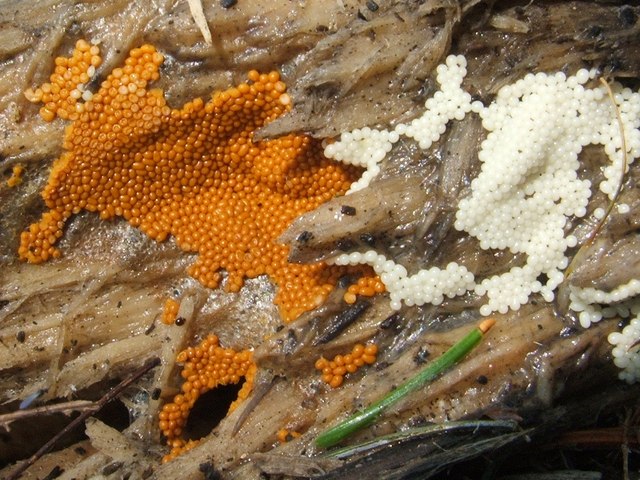2009
NS3977 : A slime mould - Trichia species
taken 15 years ago, near to Renton, West Dunbartonshire, Scotland
The Geograph Britain and Ireland project aims to collect geographically representative photographs and information for every square kilometre of Great Britain and Ireland.
Read about the Geograph Project.
Read about the Geograph Project.
We have at least 1 images that match your query [https://www..org.uk//1524494] in the area! View them now

A slime mould - Trichia species
This was just one of at least five different slime mould species (see Link for the others) that were present, all at the same time, on a particularly productive log, not far from a large artificial mound (NS3977 : Mound beside the River Leven). For scale, the orange patch on the left is about 2cm across, from left to right.
These colonies developed from an earlier plasmodial phase; at that stage, the slime mould really is slime (it looked like wallpaper paste). The plasmodium moves over the wood rather like a giant amoeba, ingesting bacteria. It later "fruits", forming the spore-producing structures (sporocarps) shown here; the sporocarps are the individual small rounded structures visible in the photo. What is left over is the so-called hypothallus, visible here as a translucent substance.
[Such densely-packed colonies are quite characteristic of T. persimilis and the similar T. scabra. In any case, two separate fruitings are shown in this image. Both are of the same species, but the one on the right came from a different plasmodium, and is two or three days less developed than the colony on the left; this is what accounts for the difference in colour.]
The sporocarps mature from white, through yellow, to the orange colour shown here, darkening further to a brownish colour. Their outer layer (peridium) then disintegrates, exposing a fluffy mass of spirally-bound threads called elaters, which bear the spores: NS3681 : A slime mould - Trichia species. On the function of elaters, compare NS3977 : A slime mould - Arcyria denudata.
The species Trichia persimilis and the closely-related T. affinis are frequently attacked by a parasitic fungus called Polycephalomyces tomentosus [see "The Myxomycetes of Britain and Ireland" by Bruce Ing], causing spiky outgrowths.
These colonies developed from an earlier plasmodial phase; at that stage, the slime mould really is slime (it looked like wallpaper paste). The plasmodium moves over the wood rather like a giant amoeba, ingesting bacteria. It later "fruits", forming the spore-producing structures (sporocarps) shown here; the sporocarps are the individual small rounded structures visible in the photo. What is left over is the so-called hypothallus, visible here as a translucent substance.
[Such densely-packed colonies are quite characteristic of T. persimilis and the similar T. scabra. In any case, two separate fruitings are shown in this image. Both are of the same species, but the one on the right came from a different plasmodium, and is two or three days less developed than the colony on the left; this is what accounts for the difference in colour.]
The sporocarps mature from white, through yellow, to the orange colour shown here, darkening further to a brownish colour. Their outer layer (peridium) then disintegrates, exposing a fluffy mass of spirally-bound threads called elaters, which bear the spores: NS3681 : A slime mould - Trichia species. On the function of elaters, compare NS3977 : A slime mould - Arcyria denudata.
The species Trichia persimilis and the closely-related T. affinis are frequently attacked by a parasitic fungus called Polycephalomyces tomentosus [see "The Myxomycetes of Britain and Ireland" by Bruce Ing], causing spiky outgrowths.
